Conservative is a loaded term. What once meant traditional, quiet, steady, demure, and prim, now means reactionary, right-wing, and hidebound. So, when I say that The Queen of the Tearling by Erika Johansen is conservative, which it clearly is, I’m references the former and not the latter. It is not, as its copious marketing copy proclaims, a ‘bright new entry in the fantasy genre’, but a capable retread of the form.
Set in the distant future, after an undescribed cataclysm, Queen of the Tearling’s Earth has fundamentally changed. A second dark age has emerged, where sickness and hunger, slaves and serfs, and violence and despotism reign again. Once a country of modest freedom, Tear has become a place of fear as the dead Queen’s brother rules as regent, steeped in liquor and slaves. Kelsea, Johansen’s protagonist and primary viewpoint, is Tear’s last hope. Now nineteen, she will leave everything she’s known behind to assume her long dead mother’s throne. Nothing resists change so well as one who rules, and her uncle has other ideas. With the Queen’s Guard at her back, Kelsea must survive her uncle’s plot to even have a chance to make things right.
Described by many as a Game of Thrones and Hunger Games combo, Queen of the Tearling sets itself up to disappoint by creating a series of underlying assumptions. Putting aside the individual components of both massively successful properties, Johansen’s novel manages to crib elements from both to smash together. Kelsea’s world is a dystopia. People are culled from the Tear population for an indeterminate purpose, and shipped elsewhere. There are swords and threats of sexual violence. While those surface details blend the milieus of the aforementioned bestsellers, the actual reading experience offers no similarities.
Where Game of Thrones is multitudinous and Hunger Games is intimate, Queen of the Tearling spends the vast majority of the book over Kelsea’s shoulder as she journeys to the throne, but diverges to the big bad villain and a gate guard at various points. The result is that Johansen tells neither a particularly broad story, nor an entirely personal one. Queen of the Tearling is decidedly stuck in limbo, with none of the advantages either extreme offers.
Furthermore, the comparisons to Game of Thrones suggest deep political story lines, complex familial relationships, and authentic maneuvering. Queen of the Tearling does none of this. Kelsea’s uncle, Thomas (don’t even get me started), remains on the throne for a decade or more as a bumbling idiot, with no explanation of how he maintains power. As an antagonist he makes even less sense, possessing no internal motivations beyond slave girls and booze. The world is whitewashed, with little to no diversity of ethnicity or sexuality. Other nation’s exist, but function as monolithic entities, not living breathing constantly shifting constructs.
Kelsea herself never manages to cross over into the beloved protagonist Johansen surely set out to create. Unlike Katniss, Kelsea’s emotions are more under wraps. Stuck outside her head in a third person point of view only lets us see how she reacts, rather than letting the reader into the constant push and pull that surely exists inside her head. While she is a bold, decisive, and daring leader, something more fantasists should be encouraged do with their female characters, she just isn’t terribly engaging. She is, perhaps, too good. Her journey is, perhaps, too simple.
Beyond failing to live up to the lofty expectations set by the marketing team, Queen of the Tearling also struggles with an overabundance of tropes. Other than Kelsea, most of the other female characters are either the victims of sexual violence or committing the violence themselves. The half-naked slave chained to the foot of the throne, or the abused woman Kelsea tries to protect, or the women carted away to slavery, there’s little to recommend Johansen’s world beyond the grimdark milieus of fantasy’s present. This is why the circulated tagline of “Game of Thrones for women” has become so pilloried. Putting aside that the vast majority of consumers of Game of Thrones are women, this is a novel that does nothing new. It is a predictable novel from start to finish.
Such an accusation doesn’t make it a bad book. In the end, The Queen of the Tearling is a perfectly capable novel. The prose is adequate, the plot interesting enough, and the characters sufficiently intriguing. In a post HBO Game of Thrones world, it’s clear that Queen of the Tearling is reaching for that mainstream audience. Is it doing it clumsily? Most certainly, but the aesthetic of Johansen’s novel is fantasy on its lowest difficulty setting. It is fantasy that even the most devoted reader of mainstream fiction can digest. In that, it’s marketing department has done it a disservice. Then again, without that disservice, I never would have looked at it twice.
The Queen of the Tearling is available now from HarperCollins.
Read an excerpt from the novel on Tor.com
Justin Landon runs Staffer’s Book Review where his posts are less on-color. Find him on Twitter for meanderings on science fiction and fantasy, and to argue with him about whatever you just read.










